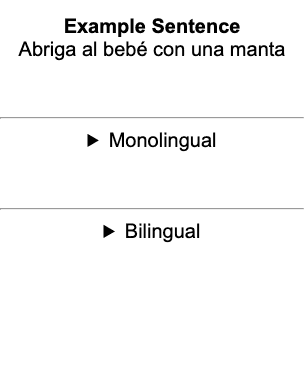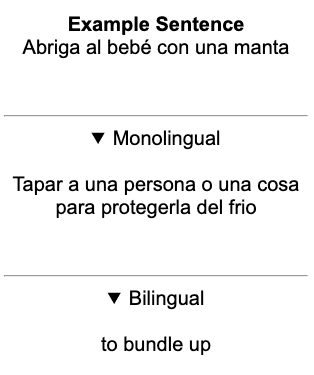Language is a tool that we use to understand the world around us. Each language is its own paradigm: a lens through which we see the world. When you first start learning a language, the natural inclination is to translate between your native language (NL) and target language (TL) because you have only ever seen the world through one lens. Unfortunately, if you attempt to force your TL to fit into the paradigm of your NL, big parts of the TL will get distorted in the process. To be truly fluent, you need to build a new paradigm for your TL.
Using a bilingual dictionary is a great tool when you first start learning a language because it uses your NL paradigm as a scaffolding for learning your TL. This scaffolding accelerates your comprehension. Unfortunately, it also tangles the two languages together and distorts the meaning of your TL.
Immersion alone is enough to untangle the languages and build this new mental paradigm, but you can accelerate the process by adopting a native (monolingual) dictionary as your primary reference guide for the language.
Building this new mental paradigm unlocks the ability to think in your TL. When you learn new words and concepts, you associate them with other TL words and concepts rather than associating them with your NL. This allows you to describe a TL concept using your TL. As an added benefit, reading a monolingual dictionary is a form of active immersion and allows you to accumulate additional time in your TL.
Using a monolingual dictionary also gives you a more accurate understanding of a word or concept. Up until now, you’ve been using a bilingual dictionary to translate the meaning of TL words into your NL so that you can comprehend. When you translate from TL to NL, you force the TL to fit into the paradigm of your NL which distorts the original meaning of the TL words. By using a monolingual dictionary instead, you can learn your TL directly without distorting the meaning.
By forming this new mental paradigm early, you will dramatically accelerate your journey to fluency.
When to Start the Transition
The monolingual transition is more difficult for some languages than others. For related languages, the transition is pretty easy and only takes 1-2 months. For these languages, we recommend making this shift towards the end of Stage 2B. The gradual transition guide we’ve provided below should be sufficient to make the switch.
For more distant languages, we recommend waiting until Stage 2C. Trying to use the monolingual dictionary before you have a solid foundation in the language is too overwhelming. By waiting, you will make the transition much easier.
If you try the gradual approach below and it doesn’t work for you, wait until Stage 2C where we’ve provided a more structured tutorial.
Gradual Transition
The monolingual transition is a gradual process. You don’t need to move 100% to the monolingual dictionary overnight (or ever, really).
When you start using a monolingual dictionary, it will take extra energy. If you find the process too draining, then revert to only using the bilingual dictionary until you have more mental energy.
1. Check the Monolingual Dictionary First
During immersion and sentence mining, start looking up words in the monolingual dictionary first before reverting to the bilingual dictionary.
Many words have multiple meanings. Try to identify which definition is relevant to the sentence you are trying to understand.
2. Add Monolingual Definition to Cards
Assuming you can figure out which definition matches the sentence you are trying to understand, add that monolingual definition to your cards in addition to the bilingual definition.
By using [HTML summary][html-summary-tags] tags, you can hide the definitions in expandable sections. While reviewing, read the monolingual definition first before the bilingual one. It’s ok if you don’t fully understand the monolingual definition. Each time you review the card, you’ll have an opportunity to try again.
If there are unknown words in the definition, then create cards for them.
Here’s a sample Anki deck with an example card type that uses the summary tag to create hidden sections:
- [Example Anki deck][sample-anki-deck-with-summary-tag]
This is what the hidden sections look like when collapsed:

Here, the hidden sections are expanded:

3. Shift to Monolingual
If you can fully understand the monolingual definition during immersion or sentence mining, then there’s no need to use the bilingual dictionary for that word. Over time, you will gradually stop using the bilingual dictionary.
You’ve completed the transition when you can understand 90% of your lookups in the monolingual dictionary without needing to rely on the bilingual dictionary.
Choosing a Dictionary
There are many monolingual dictionaries available. The way words are described can vary greatly depending on the dictionary. We recommend keeping multiple dictionaries on hand or using a dictionary aggregator so you can search multiple dictionaries at once. Reading through a word’s entries in multiple dictionaries will increase the chance you find one that makes sense to you.
When Not to Go Monolingual
Certain categories of words have disproportionately complex and convoluted monolingual definitions. It’s best to revert to the bilingual dictionary for these types of words.
Simple Words
It may seem counterintuitive at first, but very simple words often have complex and abstract meanings.
Examples
[Thing][example-definition-thing]: an object or entity not precisely designated or capable of being designated.
The: used as a function word to indicate that a following noun or noun equivalent is definite or has been previously specified by context or by circumstance.
Additionally, simple and common words can sometimes have twenty, slightly different definitions. It’s best to just use a bilingual dictionary for these words.
Concrete Nouns
Concrete nouns refer to objects that you can experience through touch, taste, and smell. The alternative is abstract nouns that describe certain ideas.
You’ve likely experienced most concrete nouns and just need to associate the TL word with that experience. Some concrete nouns have very technical or abstract definitions that don’t help you make the connection to your experience.
Examples
Piano: a musical instrument having steel wire strings that sound when struck by felt-covered hammers operated from a keyboard.
Camera: a device that consists of a lightproof chamber with an aperture fitted with a lens and a shutter through which the image of an object is projected onto a surface for recording (as on a photosensitive film or an electronic sensor) or for translation into electrical impulses (as for television broadcast).
If you find a definition that is overly technical and abstract, don’t use it. It just complicates things. Instead, see if you can use an image instead. If the target word is a place, color, species of plant or animal, or any kind of physical object, then an image is going to be more valuable than a definition.
If an image isn’t possible, then just use the bilingual definition.
Technical or Academic Terms
For academic or technical vocabulary, you can rely on the bilingual dictionary. These words have standardized technical meanings across languages, so you won’t be losing any information by using a bilingual definition.
In fact, for technical terminology, we recommend making clear associations between your NL and TL because it helps transfer technical knowledge between the languages.
For example, the word “hydrogen” means the same thing as the French word “hydrogène” and the Japanese word “水素” (suiso).
If you already know what “hydrogen” means in English, then there’s no need to learn your target language’s word for “hydrogen” through the monolingual dictionary. Simply associate the English word “hydrogen” with the corresponding word in your TL.
[example-definition-thing]: https://www.merriam-webster.com/dictionary/thing) [html-summary-tags]: https://www.w3schools.com/tags/tag_summary.asp [sample-anki-deck-with-summary-tag]: https://drive.google.com/file/d/1oRTHZ3LCQrjLeieIGjQ6qN8ljONJ1gd3/view?usp=sharing





